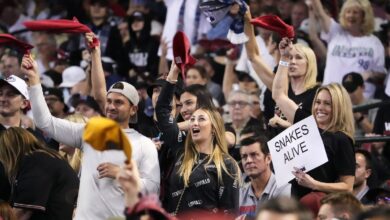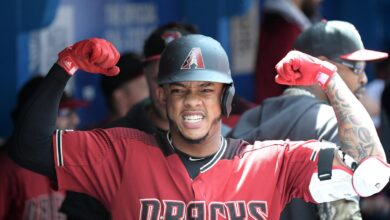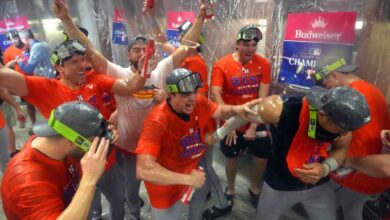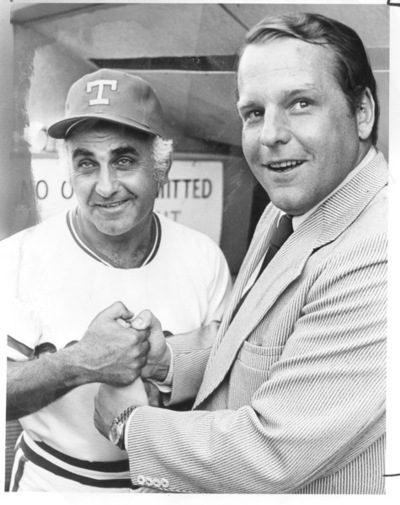
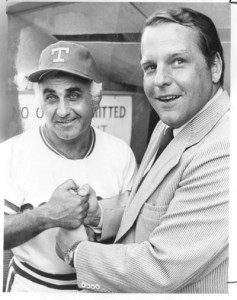
“An aggressive, affable, bright, natural-born salesman, a man with an infectious, loving and generous nature.”
“He is very creative and has great charisma … He has a love for people, and is just like a big teddy bear.”
“… He is a generous and kind man. He is also a visionary.”
Such high praise was expressed over the years about businessman Brad Corbett from close family and friends. Corbett, who was a former owner of the Texas Rangers, passed away on Christmas Eve at the age of 75. Corbett was principal owner of the club from May 29, 1974, to April 29, 1980. While those near and dear to him may have loved the self-made millionaire, to say he was a controversial figure would be an understatement. The lifetime piping industrialist from New York was a wheeler and dealer, a man who often wasn’t afraid to go above his manager or general manager to acquire a player. To his detriment, Corbett was also a highly emotional man who made bizarre statements to the press.
In fact, the man who sportswriter Mike Shropshire once described as having an uncanny resemblance to actor John Goodman “in face and torso,” was dubbed an uncomplimentary “Chuckles the Clown” by the media.
During the mid 1970s, Corbett’s win-at-all-cost mentality was not much different from Yankees owner George Steinbrenner. Like “The Boss,” Corbett made several managerial moves over his six-year tenure as owner (including firing Billy Martin, an honor which was shared by both gentleman). However, it is hard to blame him entirely for what happened in the wild season of 1977. Within a little over a week’s time, the playoff-contending Rangers changed skippers four times.
Despite never making the postseason, Texas finished in second place three times under Corbett’s ownership. The ’77 club won 94 games, the most in team history until 1999.
Bradford Gary Corbett was born in the Bronx on October 15, 1937. He was brought up in the Jackson Heights part of Queens. His parents divorced before he was born, so he was raised by his mother and grandmother. He did not come from an affluent family, as he shared a bedroom growing up with his mother and extended family.
After attending Siena College for a year with a basketball scholarship, Corbett transferred to Wagner College on Staten Island. Receiving a degree in business administration, it was at Wagner where he met his future wife, Gunhilde Grtunde. “Gunnie” as she was affectionately known, was the college homecoming queen. The couple divorced after 30 years of marriage, but they remained close friends until Corbett’s death.
Upon graduating from college in 1960, Corbett served for three years in the United States Marine Corps. After leaving the military, he worked for the Allied Chemical Corporation before founding Universal Pipe and Plastic, or UPPI. The company, which became Robintech, was a Fort Worth based manufacturer of plastic pipe used in the oil industry. He turned a $300,000 loan from the Small Business Administration into what would become the largest polyvinyl chloride pipe company in the world.
Having moved to the Fort Worth area by 1968, Corbett was a millionaire by the time he was just 32 years of age. He was not yet 40 when he bought the Texas Rangers.
Gunnie told her husband to buy the baseball team. “Robintech was making money, and things were going great for me … I wanted to buy Universal Studios, actually, but Gunnie said I knew nothing about the movie business, so I used my money to buy a baseball club instead.”
Corbett bought the team from entrepreneur and politician Bob Short, just two days before the start of the 1974 season. Corbett’s investment group paid $9.5 million dollars and picked up $1 million in debt. The group of investors included newspaper publisher Amon Carter, Jr., local developer Raymond Nasher and former Yankee third baseman Dr. Bobby Brown. A trained cardiologist, Dr. Brown would go on to become sixth president of the American league.
Short had been much reviled by fans in the nation’s capital for moving the Washington Senators from D.C. to the Dallas-Fort Worth area. Things didn’t help matters when his club lost 100 games or more in its first two seasons in the Lone Star state.
Unfortunately, Corbett and the new ownership were just as clueless about running a baseball team as Short. There was an introductory press conference announcing the sale of the team to Corbett’s group, which the Star-Telegram’s Shropshire described as nothing short (no pun intended) of a circus.
“The new Rangers deed-holders at the hastily arranged meeting with the media [after purchasing the club] were woefully ill prepared to answer any specific questions concerning actually who owned what and how much they had paid for whatever it was that they weren’t sure that they owned.”
Many of Corbett’s baseball decisions fell on other people’s shoulders. This list of people included Dr. Brown, who took off six months from his practice to become team president, and former Atlanta Braves GM Eddie Robinson. Robinson described Corbett as having a “passion for talking trades.” Furthermore, “The only way I can describe it is he (Corbett) was like a kid with a new toy when he got the Rangers. He would call me all hours of the night and say, ‘Hey, Eddie, do you think I should trade so-and-so for so-and-so? My wife Bette and I never got any sleep. He did the same thing to Dr. Bobby Brown when he was in with a patient.”
Dr. Brown first met Corbett in ’74. “He was interested in baseball, and I was a former player … When Brad bought the Rangers, he didn’t know much about running a club, so he asked me to do it for him.”
Whatever help Corbett had, his club had a tremendous 1974 season.
With a full season of Billy Martin as their skipper, the Rangers had their first winning campaign (84-76). The team finished five games behind the world champion Oakland A’s, while improving by a whopping 27 games from 1973. Martin won Manager of the Year, first baseman Mike Hargrove won AL Rookie of The Year and outfielder Jeff Burroughs won the MVP. Also, future Hall of Fame pitcher Fergie Jenkins had 25-12 record, which earned him Comeback Player of the Year. Most importantly for ownership, the Rangers doubled their attendance from the previous season.
“We put a good team together that first year, signed some free agents and ended the season with the second-best record in the American League,” said Robinson.
Despite the success of 1974, there was no love lost between Martin and his new owner. Short had allowed Martin to make some front office decisions, including when to call up players from the minors. It was Short, in fact, who once said he would “fire my mother for the chance to hire Billy Martin.” Things were different with Corbett, however. As was usually the case with Billy, a series of incidents would ultimately lead to his dismissal. Martin would get into several fights, including one aboard a plane with traveling secretary Burt Hawkins. Berating his players, he lost any semblance of respect from the team, and the club floundered.
He even ripped the owner, proclaiming that Corbett “knew as much about baseball as I know about pipe.”
Corbett fired Martin on July 20, 1975. The Rangers stood at 44-51.
Third base coach Frank Lucchesi replaced Martin as skipper, and the team finished in third place, under .500. Lucchesi continued to manage the Rangers the following season and led the club to a fourth-place finish in the American league West. It was 1977, however, that proved to be the most interesting season under Corbett’s watch.
There were many on-field accomplishments for the 1977 Texas Rangers. On May 15, outfielder/DH Willie Horton became the first Ranger to hit three home runs in a game. On August 8, in the second game of a doubleheader versus the Oakland A’s, the team pulled off the first triple play in team history. Finally, on August 27, infielders Toby Harrah and Bump Wills became the second players in MLB history to hit back-to-back, inside-the-park home runs. The feat was accomplished at Yankee Stadium, and on consecutive pitches.
It was off the field, however, (or more accurately in the dugout), where the team had its most distractions. Lucchesi was fired with the team struggling around .500. A spring training confrontation with infielder Lenny Randle over playing time, not only sent Lucchesi to the hospital with serious injuries, but also made a case that he couldn’t get a handle on his team.
On June 22, 1977, with his club at 31-31, Corbett replaced Lucchesi with Eddy “The Brat” Stanky manager. The three-time All-Star second baseman had played with the Dodgers, Cubs, Braves, Giants and Cardinals. He was named Sporting News Major League Manager of the Year for leading the Redbirds in 1952. Stanky was also a successful skipper in the minors and at the University of South Alabama.
Stanky’s tenure as skipper of the Rangers, though, is among the shortest managerial stints in baseball history. The day after a 10-8 win over the Twins, Stanky resigned, telling now team president Eddie Robinson, “I can’t take the job … I’m homesick for my family.”
Corbett went to work again. This time, Connie Ryan was named interim skipper and managed six games before the hiring of Billy Hunter. Hall of Famer Harmon Killebrew had also been interviewed for the job.
Hunter was hired as the fourth and final manager for the ’77 Rangers season on June 28. The club played well, as the team concluded the regular season schedule 60-33 under the rookie manager. First baseman Hargrove said of Hunter, “He came in here and showed a perfect blend of knowing how to handle people, plus knowing the game. If you took a jar, put Billy Martin and Frank Lucchesi in that jar, shook it up, then emptied it out, out would come Billy Hunter. He combines the best qualities of both our previous managers.”
For his part, Corbett had strange public reactions to his team’s misfortunes. Following a 1-0 loss to Kansas City on July 4, he told his clubhouse and the press that his team was a bunch of animals. “I’m selling this team because it’s killing me. They are dogs on the field, and they are dogs off the field.”
It should lastly be mentioned that Corbett once (at least that we know of) famously made a trade with Indians GM Gabe Paul while both were standing at a urinal at a local Fort Worth restaurant. Given Paul’s close friendship with Corbett, it was not uncommon for the two to discuss late-night trades in bars. One such deal, which sent slugger Bobby Bonds and pitcher Len Barker to the Rangers for Indians infielder Larvell Blanks and pitcher Jim Kern, was consummated in a bathroom.
“We’d been at the Old Swiss House restaurant in Fort Worth,” recalled Corbett. “Haggling over the trade for hours. It was after midnight, the place was fixin’ to close and we still hadn’t finalized anything. Before we left, both of us had to take a leak. While we were in the john, we decided ‘Oh hell, let’s make a deal’ and we shook on it.”
Corbett made other deals late into the night. “I got [free agent] Richie Zisk at four in the morning, and I got Dock Ellis [purchased from the A’s] in the middle of the night, too.”
In the end, he had regrets over many of the deals he made, which included spending heavily on free agents like Zisk, Bert Campaneris and Doyle Alexander, while trading away Hall of Famers Jenkins, Gaylord Perry and Bert Blyleven. The amount of turnover during the Corbett era is remarkable and speaks for itself. The team he inherited from spring training in 1974 had a 40-man roster with 14 top minor league prospects. By the spring of 1979, only one player remained from those 54, catcher Jim Sundberg.
Corbett admitted that running a baseball team was not like running any other business. By the late ’70s, things started to go sour for him and his club. Many of his other business ventures failed, necessitating a change in ownership. Revelations about his son Brad, Jr. taking part in trade discussions certainly didn’t help to improve either his image or the club’s.
Finally, on April 29, 1980, Corbett sold majority interest in the Texas Rangers to H.E. “Eddie” Chiles for a reported $12 million, and $14 million in contingent liabilities.
Before his passing, he was an active philanthropist. Among other causes, Corbett was on the board of the Killebrew-Thompson Memorial Golf Tournament, which helps raise money for Leukemia research. He received the prestigious Ellis Island Medal of Honor in 1990, was admitted to the Texas Sports Hall of Fame in 1974, and the Texas Baseball Hall of Fame in 1992.
Sources:
100 Things Rangers Fans Should Know & Do Before They Die, by Rusty Burson. Triumph Books, Chicago, 2012.
Seasons in Hell: With Billy Martin, Whitey Herzog and “The Worst Baseball Team in History” – The 1973-1975 Texas Rangers. By Make Shropshire. University of Nebraska Press, 1996.
Big Hair and Plastic Grass: A Funky Ride Through Baseball and America in the Swinging ‘70s. By Dan Epstein. St. Martin’s Press, NY, 2010.
Billy Martin, with Peter Golenbock. “Number 1”. Delacorte Press, 1980.
“Brad Corbett, who owned the Texas Rangers, Dies at 75,” by Bruce Weber, New York Times, 12/26/12.
“Corbitt’s Orbit,” Fort Worth Business Press, Fort Worth, TX, by Gail Bennison, 2003.
“Sports Trade Winds,” by Norm Hitzges, D Magazine, March 1979.
“Billy Martin”, SABR BioProject, by Jimmy Keenan and Frank Russo.
“Connie Ryan”, SABR BioProject., by John McMurray.
“Billy Hunter”, Pitching, Defense, and Three-Run Homers: The 1970 Orioles. By Michael Huber. Society For American Baseball Research, 2012.
“Eddy Stanky”, from The Team that Forever Changed Baseball and America. By Alex Edelman, University of Nebraska Press, 2012.
Baseball-reference.com
Baseball-almanac.com



